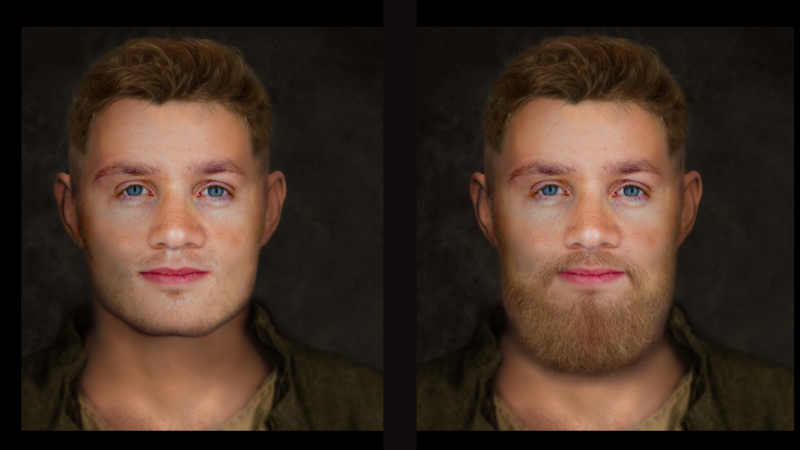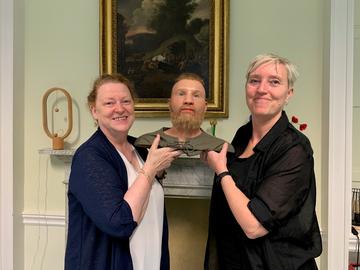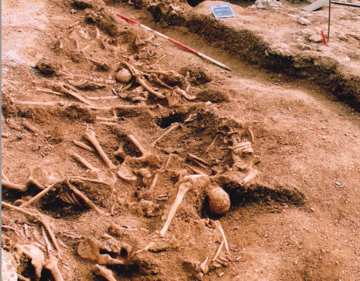ST JOHN’S AND THE ST BRICE’S DAY MASSACRE

ST JOHN’S AND THE ST BRICE’S DAY MASSACRE
13 November is loaded with meaning for St John’s College, where the victims of a massacre in 1002 were rediscovered in 2008
Published: 20 November 2023
Author: Richard Lofthouse
Share this article
The annual Christian feast day of 13 November refers to St Brice, fifth-century Bishop of Tours. It is marked in the University diary, Britius, and the only church in England dedicated to the saint is in Brize Norton, also in Oxfordshire.

On this ominous day in 1002, a massacre of Danish males took place in Oxford following an order from the King
Piecing the narrative together at a special lecture at St John’s College on Monday 13 November, amidst a much broader sequence of events, talks and an exhibition open to the public to mark the massacre, was Professor of Archaeology David Griffiths.
All the evidence suggests that a concentrated Danish enclave lived in St Clement’s. The King perceived a threat to his life after two decades of intermittent raids carried out along English rivers such as the Trent and the Thames.

A mob would appear to have gathered. The Danes fled to St Frideswide (today’s Cathedral, within Christ Church) believing it their best chance of sanctuary but it was set alight and great violence ensured with c.37 males hacked and stabbed to death that day, subsequently carried or carted to a dumping ground within an ancient henge situated in what is today’s St John’s College, Kendrew Quad (pictured right in 2008, upon rediscovery).
Talking more broadly about Oxford in the time of the Vikings, Professor Griffiths explained that the term ‘Viking’ was seldom used historically. Viking raiders whether from Norway or Denmark were typically referred to as ‘Danes, ‘Northmen’, ‘gentiles’ or simply ‘foreigners’. The term Viking refers to ‘vik’ or inlet or bay, a reference to people of the bay and a reference explained by the fact that they made their way as far west as Cirencester.
While it is not proven, the Hook Norton Hoard discovered in 1848 supports the notion that they may have also proceeded up the Cherwell River, while the more recently discovered Watlington Hoard of 2015 confirms that Oxfordshire was important to the Viking settlement. Both discoveries form part of the context for the St Brice’s Day massacre.
The skeletons were discovered in 2008 at the start of the Kendrew Quadrangle building project. Their random position and injury detail show that they were dumped without any ceremony or burial rite.
The put-upon King – known as the ‘Unready’ – achieved nothing by the awful events of that day in 1002, for Oxford was again raided in 1009 and submitted to Svein Forkbeard in 1013.
On 12 and 13 November, St John’s College marked the St Brice’s Day massacre with a series of public-facing talks and events that reflected on the history of the College and its connection with 11th-century Oxford. Starting with a walking tour of Anglo-Saxon Oxford to set the geographical context for the massacre, a number of guest speakers, led by Professor Dame Sue Black, President of St John’s, were welcomed to the College where they discussed themes of identity, both of Anglo-Saxons and Vikings, and of conflict. Speakers from St John’s included Professor Hannah Skoda and Professor Carolyne Larrington, as well as author Dr Amy Jeffs and Professor Caroline Wilkinson, Director of FaceLab at Liverpool John Moores University.
The programme also included the unveiling of ‘Johannes’ a 3D facial reconstruction of the skull of one of the skeletons found in the mass grave and its receipt into the College’s art collection. Intriguingly the connection with the events of 1002 still had a strong resonance today: Tom Shaw, a 2023 graduate in Ancient and Modern History, had found that he had a very strong DNA match (in the top 1%) with the St John’s skeletons. The programme spanned 12–13 November 2023 and was titled ‘Remembering St Brice’s Day’.
IMAGES:
Lead image, recreating two faces of the Danes killed in 2002, (credit: Facelab). Image of skeletons, re-discovered in 2008 in Kendrew Quadrangle, St John's College, (credit: Thames Archaeological Society). Portrait of Professor Dame Sue Black, President of St John's College (L) and Professor Caroline Wilkinson, of Liverpool John Moores University (R) with the reconstructed head of one of the slain Danes (credit: St John's College).















